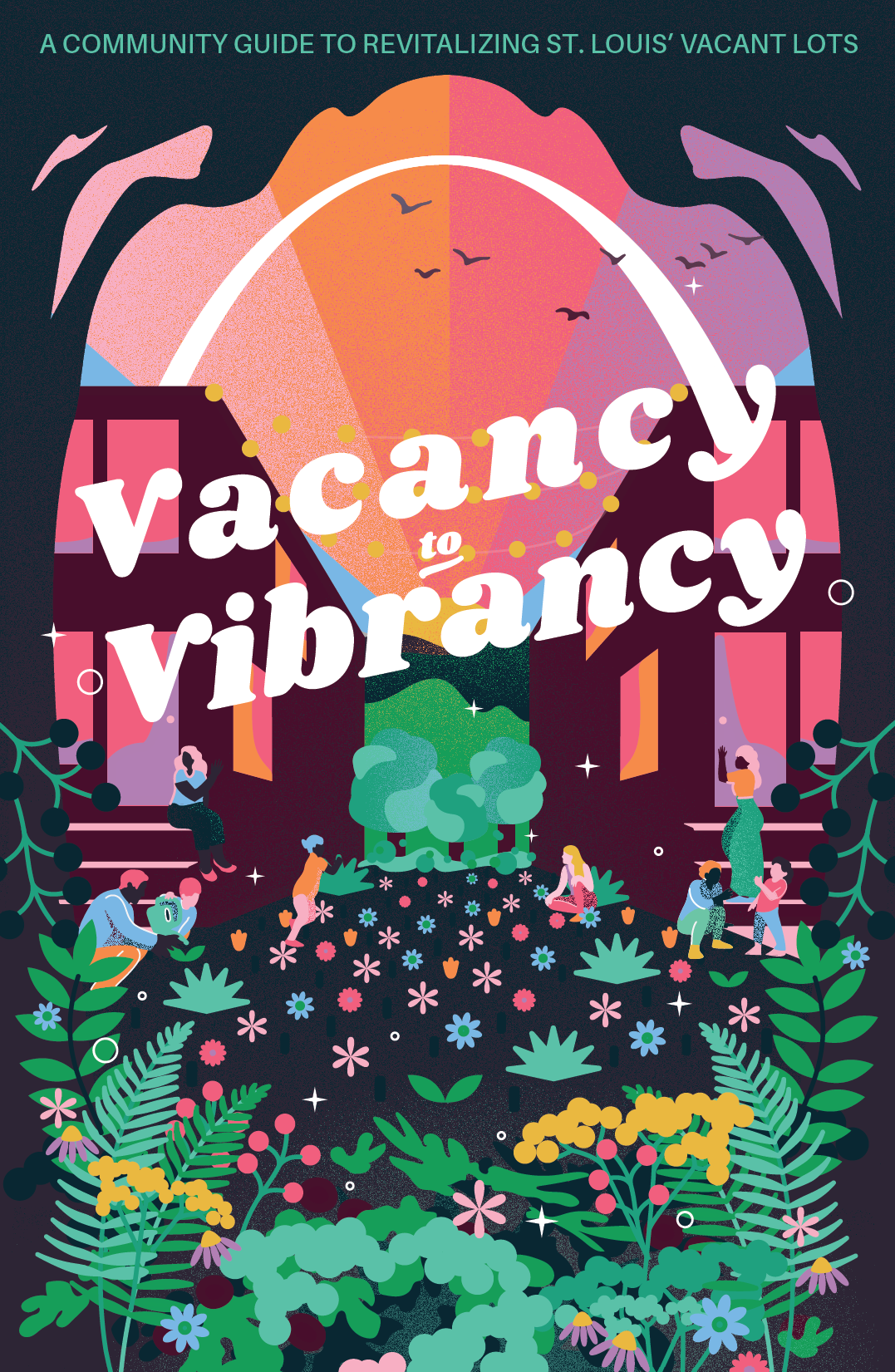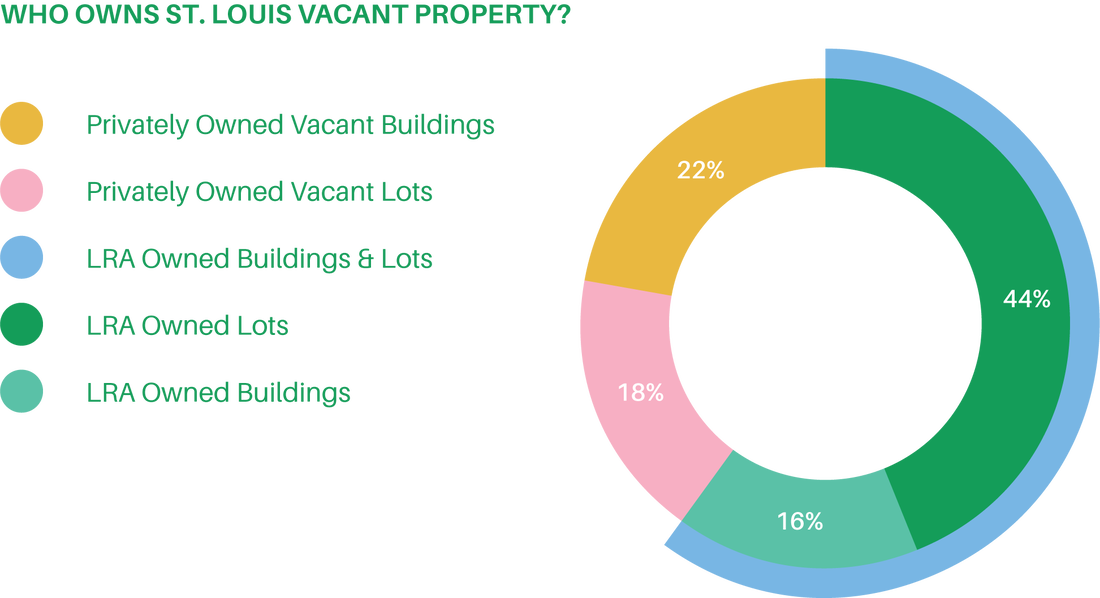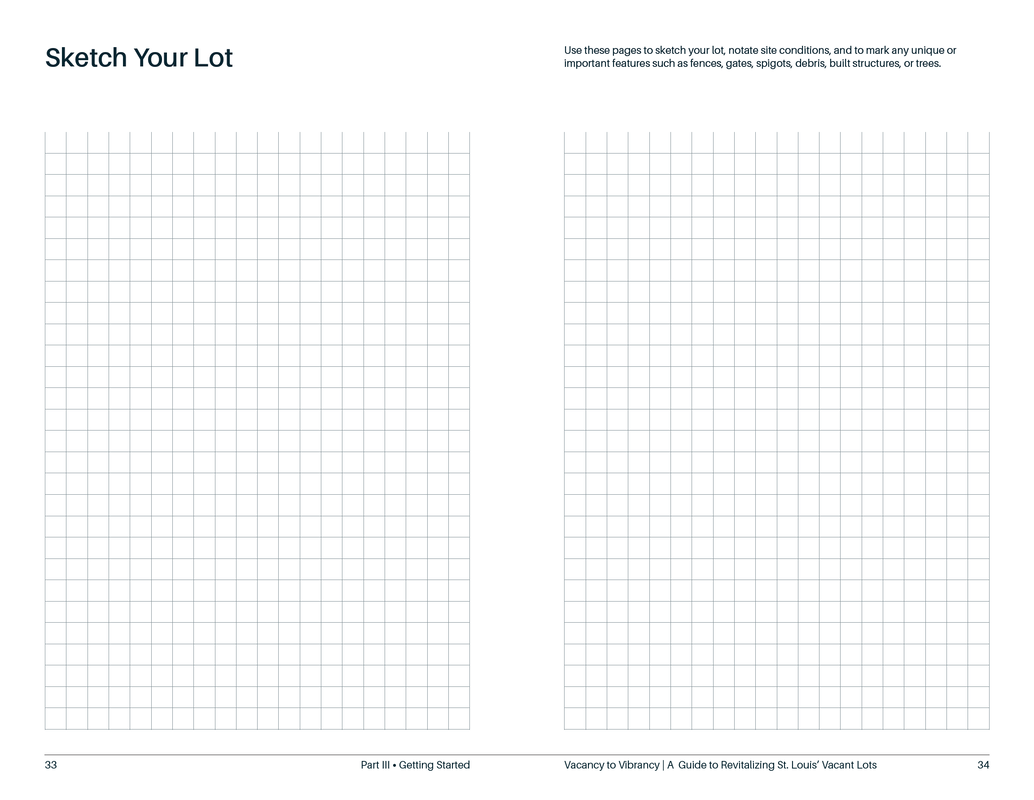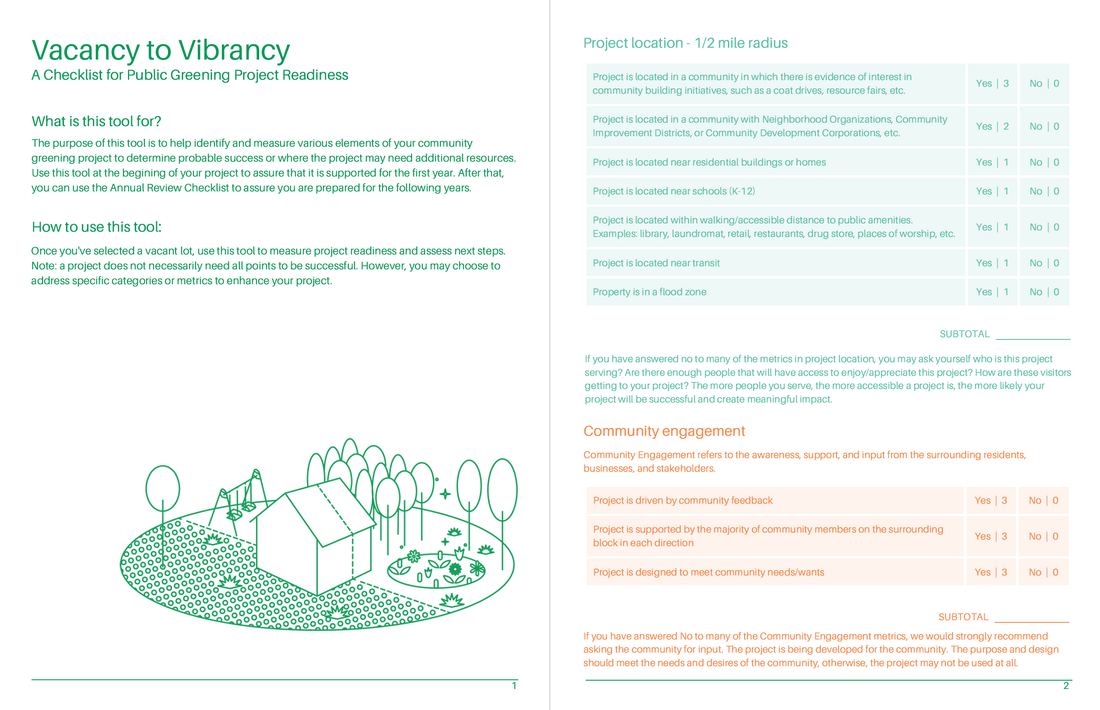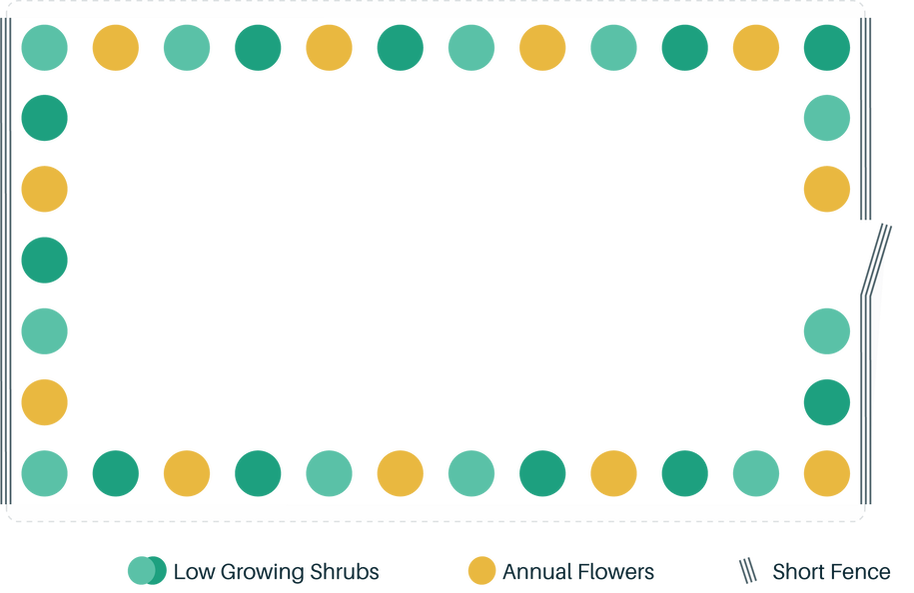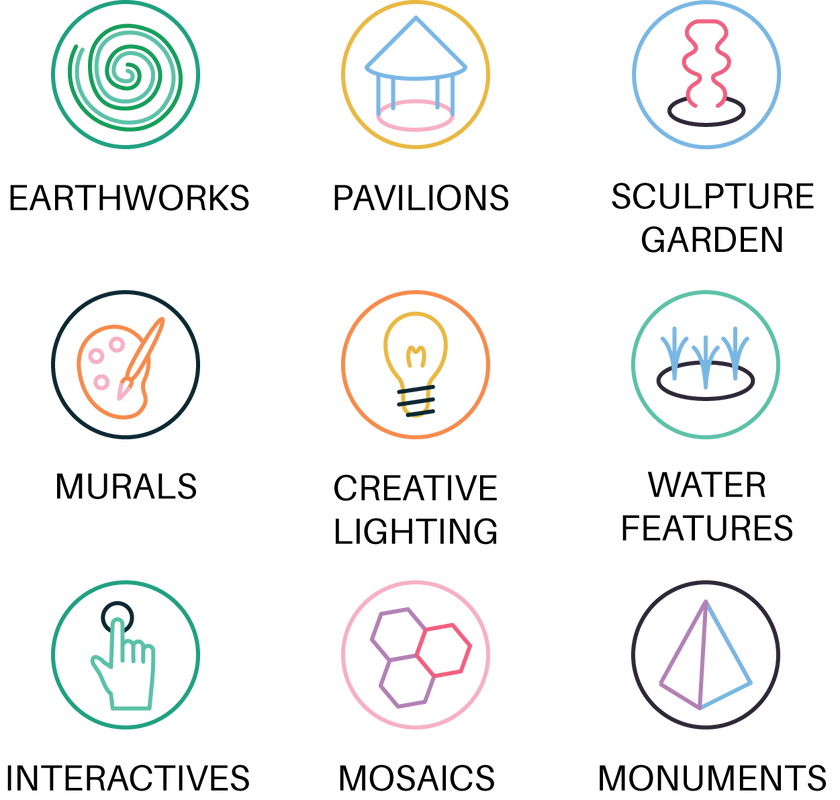-
Introduction
-
Acquiring a lot
-
Getting started
-
Project ideas
-
Resources
<
>
-
About the toolkit
-
Vacancy in St. Louis
-
Community green spaces
<
>
|
This resource guide was developed as a tool for neighbors and community organizations interested in revitalizing a vacant lot in the City of St. Louis. While each vacant property presents an opportunity for community-led reinvestment, even small investments can feel as difficult to navigate as large-scale developments. This guide was developed to help neighbors make informed plans, and to weigh the potential of a project with the reality of any additional burdens—from the investment of your time and energy to property acquisition and ownership.
This guide contains project descriptions, site plans, budgets, worksheets, lists of tools, local resources—everything needed to hit the ground running with a successful revitalization project. To consider all potential opportunities and challenges with a reuse project, we encourage users to move through the sections in order. Some sections, however, are designed as worksheets or resources that can be printed, shared, and reused. |
|
The City of St. Louis has a serious vacancy challenge, with nearly 25,000 vacant and abandoned properties. Since 1950, when our population reached its historic high of 850,000 people, we have experienced a 63% decline, resulting in one of the highest rates of vacancy in the nation. The land cover of vacant properties in the City is equal to nearly two Forest Parks.
|
Traditionally, when we think of vacant properties in our city, we think of our historic brick buildings, wishing someone would rehab them. But most of our vacant properties (57%) are vacant lots—open parcels of land that usher in their own host of problems for nearby residents. When vacant lots are abandoned or poorly maintained, they attract illegal dumping and violent crime, suppress community pride, and place added burdens on City departments and nearby residents.
The prevalence of vacant and abandoned properties today can represent a significant opportunity to reinvest in the future of our neighborhoods. Collaborative efforts to develop solutions are helping to reveal our past mistakes, rebuild relationships and trust, and create new forms of equitable reinvestment. The complex challenge of vacancy in St. Louis can only be addressed through a collective effort and a large toolbox. Just one of the tools in our toolbox is the temporary and permanent reuse of vacant lots as community open spaces.
|
A community green space is any intentional open space maintained for community use. It can be a venue for exercise and physical activity, for relaxation and stress reduction, for growing and sharing food, for experiencing arts and entertainment, for interacting with nature, or any number of combinations.
|
Greening projects can be relatively cost effective and quick interventions that provide a variety of social, environmental, and economic benefits. These community benefits can be realized with any range of investment, from routine mowing to production agriculture. Greening projects are adaptable to your budget, your capacity, and your level of experience. Every project, no matter how small, makes a difference in your neighborhood.
Increased access to green spaces can reduce stress, anxiety and even crime; prevent illegal dumping; encourage social interactions; increase property values; and improve physical and mental health. Green spaces may help catalyze additional development, and they can increase a community’s ability to withstand the impacts of climate change, like increasing and intensifying storm events.
The benefits are wide-ranging, and are best realized through active local design and use. A community greening project should be led by residents and designed to meet the interests and priorities of the surrounding community. No matter your use, your green space should reflect your community, aim to meet your collective aspirations, and provide a welcoming environment for all neighbors to interact.
Increased access to green spaces can reduce stress, anxiety and even crime; prevent illegal dumping; encourage social interactions; increase property values; and improve physical and mental health. Green spaces may help catalyze additional development, and they can increase a community’s ability to withstand the impacts of climate change, like increasing and intensifying storm events.
The benefits are wide-ranging, and are best realized through active local design and use. A community greening project should be led by residents and designed to meet the interests and priorities of the surrounding community. No matter your use, your green space should reflect your community, aim to meet your collective aspirations, and provide a welcoming environment for all neighbors to interact.
-
Determine the owner
-
LRA Lots
-
Other Considerations
<
>
Determining the current owner
To search for a vacant lot and determine its ownership, use the Vacant Property Explorer.
To search for a vacant lot and determine its ownership, use the Vacant Property Explorer.
- If a vacant lot is publicly owned, it is under the stewardship of the Land Reutilization Authority of the City of St. Louis (LRA).
- If the lot is privately owned, steps will need to be taken to contact the current owner.
The Land
|
In 1971, to combat the increasing challenge of abandoned properties, the City of St. Louis established the first land bank in the United States, the Land Reutilization Authority (LRA). LRA is a nonprofit organization with the mission of receiving and holding vacant and abandoned tax foreclosed properties until new private owners can purchase the properties and return them to productive use.
|
LRA Online Explorer
Visit to learn more about programs offered by the LRA.
Visit to learn more about programs offered by the LRA.
LRA Property Search
Visit the LRA Property Search to find information on a vacant property.
If you see a property on the Explorer that is owned by LRA but it does not appear in the LRA-Owned Property Search, it may be held for pending offers or sales, during title or lien work, or because of an existing lease – contact the LRA!
Visit the LRA Property Search to find information on a vacant property.
If you see a property on the Explorer that is owned by LRA but it does not appear in the LRA-Owned Property Search, it may be held for pending offers or sales, during title or lien work, or because of an existing lease – contact the LRA!
Side Lot
Eligible Lots
Lots up to 30 feet frontage (the width of the parcel facing the street) and under certain circumstances up to 50 feet frontage, to be sold as additional side yard to the owner of an adjacent residential property. You can find frontage for a specific lot on the LRA-Owned Property Search.
Applicant Eligibility
Applicants must own the adjacent property, have paid all taxes on properties owned in the city, and have no outstanding code violations on those properties.
Application Process
Applicants must complete the following required documents:
Fees
A $25.00 non-refundable processing fee is required when making an offer.
Lots up to 30 feet frontage (the width of the parcel facing the street) and under certain circumstances up to 50 feet frontage, to be sold as additional side yard to the owner of an adjacent residential property. You can find frontage for a specific lot on the LRA-Owned Property Search.
Applicant Eligibility
Applicants must own the adjacent property, have paid all taxes on properties owned in the city, and have no outstanding code violations on those properties.
Application Process
Applicants must complete the following required documents:
- The Offer Checklist
- LRA Offer to Purchase
Fees
A $25.00 non-refundable processing fee is required when making an offer.
Mow to Own
Residents may take ownership of a vacant lot that is located next to an occupied residential or commercial property that they own, for a nominal fee. Participants must agree to continually maintain the lot for 2 years.
Eligible Lots
A lot may not exceed 40 feet frontage and must be the property of the LRA for a minimum of three years.
Applicant Eligibility
Applicants must own the adjacent property, have paid all taxes on properties owned in the city, and have no outstanding code violations on those properties.
Application Process
Download the Mow-To-Own application online or pick up an application in the LRA office at 1520 Market St., Suite 2000.
Fees
A $25.00 nonrefundable processing fee is required when making an offer, followed by a $100 fee, at closing, after the 2-year period.
Eligible Lots
A lot may not exceed 40 feet frontage and must be the property of the LRA for a minimum of three years.
Applicant Eligibility
Applicants must own the adjacent property, have paid all taxes on properties owned in the city, and have no outstanding code violations on those properties.
Application Process
Download the Mow-To-Own application online or pick up an application in the LRA office at 1520 Market St., Suite 2000.
Fees
A $25.00 nonrefundable processing fee is required when making an offer, followed by a $100 fee, at closing, after the 2-year period.
Garden Lease
Residents may lease LRA lots for up to a five year period to create vegetable and/or flower gardens.
Eligible Lots
Lots that are not currently planned for development are eligible.
Applicant Eligibility
Available to individuals, neighborhood associations, and community organizations. Lessee is responsible for maintenance and liability insurance.
Application Process
Download the Garden Lease Application and submit completed form to the St. Louis Development Corporation.
Fees
$1.00 per year ($5.00 for the five year lease).
Eligible Lots
Lots that are not currently planned for development are eligible.
Applicant Eligibility
Available to individuals, neighborhood associations, and community organizations. Lessee is responsible for maintenance and liability insurance.
Application Process
Download the Garden Lease Application and submit completed form to the St. Louis Development Corporation.
Fees
$1.00 per year ($5.00 for the five year lease).
Insurance
General liability insurance is recommended for all project sites, and event insurance may be necessary for large public gatherings. Reach out to an insurance agent for quotes and recommendations.
If you lease a vacant lot through the LRA’s Garden Lease program, you are required to obtain general liability insurance in an amount not less than $300,000.00. The full requirements are listed here.
Permitting
Permits can be required for everything from sign installation to fencing, sheds, and events. Be sure to contact the Building Division to determine if your project will need permits for: Construction (earth moving, fencing, sheds, playgrounds, large signage, etc.), Occupancy (business operations), or Events (large public or special events.)
Contact the St. Louis City Building Division’s Permit Section to find out more.
City Codes
Once you own a lot, you’ll need to ensure that you keep it up to the City Code and prevent overgrowth, cleanup trash, and keep the site clean. For more information, contact the St. Louis City Building Division.
General liability insurance is recommended for all project sites, and event insurance may be necessary for large public gatherings. Reach out to an insurance agent for quotes and recommendations.
If you lease a vacant lot through the LRA’s Garden Lease program, you are required to obtain general liability insurance in an amount not less than $300,000.00. The full requirements are listed here.
Permitting
Permits can be required for everything from sign installation to fencing, sheds, and events. Be sure to contact the Building Division to determine if your project will need permits for: Construction (earth moving, fencing, sheds, playgrounds, large signage, etc.), Occupancy (business operations), or Events (large public or special events.)
Contact the St. Louis City Building Division’s Permit Section to find out more.
City Codes
Once you own a lot, you’ll need to ensure that you keep it up to the City Code and prevent overgrowth, cleanup trash, and keep the site clean. For more information, contact the St. Louis City Building Division.
Some people say that the hardest part of any project is getting started. These worksheets will help you think about who you think about who you want on your team, your local assets, and what project you want to create, so you can break through that first barrier.
Click on each worksheet to download a PDF version.
Click on each worksheet to download a PDF version.
Check out the project ideas below to help you decide how to transform your space. Clicking on each project idea will bring you to a new page with more information.
-
St. Louis Resources
-
Planting Guide
<
>
This resource guide is meant to provide you with contact details about civic, nonprofit, and material resources in the St. Louis area.
Help keep us up to date!
We strive to keep this list updated with every new release. Help us by letting us know when information about your organization has changed! Notify us by filling out this contact form.
Help keep us up to date!
We strive to keep this list updated with every new release. Help us by letting us know when information about your organization has changed! Notify us by filling out this contact form.
|
Lot Ownership Information
Vacant Property Explorer City of St. Louis Assessor’s Office (314) 622-4050; (314) 622-4185 for property appraisal Citywide Address & Property Search LRA-Owned Property Search |
Acquiring a Lot
St. Louis Development Corporation Real Estate (314) 657-3721 Purchase LRA Property Mow-To-Own Program Garden Lease Program |
|
Public Art and Art Grants
National Endowment for the Arts Grants Project for Public Spaces Regional Arts Commission Grants |
|
City Services and Problem Reporting
Citizens’ Service Bureau Report problems and request services from the City of St. Louis (e.g., removing illegal dumping, problems with alley dumpsters, street lights, etc.). (314) 622-4800 | @stlcsb on Twitter Report a Downed Power Line Ameren of Missouri 1 (800) 552-7583 St. Louis Water and Sewer Authority |
Dumping & Refuse
City Transfer Stations Have excessive debris on your lot? Every year, St. Louis City residents can bring up to 12 loads of trash, yard waste, recycling, bulk, or BOAT (car batteries, motor oil, appliances and car tires) items to City Transfer Stations. ID must be shown at drop-off. Residential refuse drop off: North: 201 North Humboldt, 63147 South: 4100 South First Street, 63118 8:00 a.m. – 4:00 p.m. Monday—Sunday |
|
Tools & Equipment Rentals
Brightside St. Louis (314) 772-4646 Borrow hand tools or request a roll-off dumpster for large cleanups. Yard waste must be separated from trash and bulk items; For non-profits or groups working on LRA-owned lots only. Lowe’s Menards Many hardware stores rent lawn equipment, power tools, and trucks to help tackle larger-scale projects. |
Soil Testing
University of Missouri-Extension Soil testing is an important step before starting any project. For a small fee, groups can purchase a standard soil test, which will give information about the composition of their soil. Lead and other heavy metals testing is available for an additional fee. |
|
Gardening & Horticulture
Forest Releaf of Missouri Pocket Parks Project Clear Grants Metropolitan Sewer District Grow Native! Plant Database Missouri Prairie Foundation City of St. Louis Street Tree Information St. Louis Invasive Species List Seed St. Louis (314) 588-9600 Seed St. Louis supports over 200 gardens in the St. Louis region with vegetable seedlings, tool loans, planning services, and technical assistance. Gateway Greening gardens that have operated successfully for 5+ years may be eligible to be included in their land trust. Missouri Botanical Garden Horticulture Answer Service (314) 577-5143 9:00 a.m. – 12:00 p.m. Monday—Friday Free online guides and fact sheets, as well as technical assistance with edible garden/orchard design & installation (paid service) Missouri Botanical Garden Plant Finder App Use this app for identifying thousands of plants and learn more about their characteristics and preferred conditions. Shaw Nature Reserve Custom Foodscaping Good Life Growing Milkweed for Monarchs: The St. Louis Butterfly Project |
Playground Information
Whole Building Guide Playground Design & Equipment Public Playground Safety Checklist Playground Ideas Kaboom! Organization that provides resources to communities looking to create safe and equitable playspaces for their children |
This resource guide is a step-by-step guide for successfully planting native and zone appropriate plants.
Looking for a list of plants native to Missouri? Download our list.
Help keep us up to date!
We strive to keep this list updated with every new release. Help us by letting us know when information about your organization has changed! Notify us by filling out this contact form.
Looking for a list of plants native to Missouri? Download our list.
Help keep us up to date!
We strive to keep this list updated with every new release. Help us by letting us know when information about your organization has changed! Notify us by filling out this contact form.
HOW TO PLANT
|
STEP 1: TIME IT RIGHT
The best time to plant is either spring or fall. If not planting immediately, leave plants in their preferred amount of light, and keep their soil slightly moist. STEP 2: DIG & PLACE A - For each plant, dig a hole as deep and twice as wide as the container the plant came in. B - Gently break up the root ball of each plant and place plants in their holes with roots spread out. C - The bottom of the root ball should rest on a mound of native soil. STEP 3: BACK-FILL WITH SOIL D - Backfill with native soil only and lightly compact to remove airpockets. The top of the root ball and root crown should be level with the existing soil STEP 4: MULCH THE BASE E - Cover with a layer of mulch, creating donuts around trees and larger plants. Leave space around the plant–do not mound soil or mulch right up against the trunk or stem. STEP 5: WATER Soak your garden immediately, monitor for moisture daily by sticking your finger below the mulch into the soil. Your plants should get roughly 1” of water per week–more when it’s hot! |
|
F - If using a hose or sprinkler, make sure the water is applied below the leafing structure of the plant and is reaching the roots.
G - When possible, water around the base of your plants in the early morning so that they have enough time to take up the water before the hottest parts of the day. H - If using a drip irrigation system, make sure that your lines are close enough to the top of the root ball, so that the moisture is actually getting where it needs to go. TWEAK YOUR ROUTINE TO FIT Plants that are getting established will need daily water, but their watering needs may change. Established plants may only need to be watered weekly, but may require even more in hot weather. |
HOW TO WATER
REMINDERS
DESIGN YOUR GARDEN
Space plants according to guidelines provided on plant tags, or search online for proper spacing. Up against a wall or fence? Place taller species in the rear. For gardens viewable from all sides, place taller species
towards the center.
INSULATE
During cold temperatures, insulate the area around the plants with fallen leaves or more mulch.
DESIGN YOUR GARDEN
Space plants according to guidelines provided on plant tags, or search online for proper spacing. Up against a wall or fence? Place taller species in the rear. For gardens viewable from all sides, place taller species
towards the center.
INSULATE
During cold temperatures, insulate the area around the plants with fallen leaves or more mulch.
MAP OF LOCAL PROJECTS
You can view the map legend by clicking the icon in the top left corner.
If you would like to add your community greening project to this map, please submit a contact form.
MEET THE TEAM
-
St. Louis Vacancy Collaborative
-
Green City Coalition
-
Arbolope Studio
<
>
The Vacancy Collaborative is a coalition of community representatives, private and nonprofit stakeholders, and City agencies, committed to reducing vacant property in the City of St. Louis. Reducing the negative impact of vacancy is a complex puzzle that requires coordination to achieve a shared vision. The Vacancy Collaborative is not a stand-alone entity—it was created to coordinate existing vacancy efforts under one umbrella, and to support the public and private sectors in working together toward comprehensive solutions.
The Reinvestment & Reuse Working Group, one of six collaborative working groups, focuses on identifying and promoting financial and sustainable solutions to equitably reinvest in vacant property. Topics include small contractor and rehabber development, financial reinvestment tools and historic preservation, and alternative land uses like those presented in this guide.
The Reinvestment & Reuse Working Group, one of six collaborative working groups, focuses on identifying and promoting financial and sustainable solutions to equitably reinvest in vacant property. Topics include small contractor and rehabber development, financial reinvestment tools and historic preservation, and alternative land uses like those presented in this guide.
Green City Coalition (GCC) is a collective initiative of state, city, community organizations, and neighbors working collaboratively to develop and conserve green spaces that promote healthy, vibrant and engaged St. Louis neighborhoods.
GCC has cooperative agreements with the Missouri Department of Conservation, City of St. Louis, St. Louis Development Corporation, Metropolitan St. Louis Sewer District, and Missouri Conservation Heritage Foundation, with additional members varying by neighborhood, program, or project.
GCC has cooperative agreements with the Missouri Department of Conservation, City of St. Louis, St. Louis Development Corporation, Metropolitan St. Louis Sewer District, and Missouri Conservation Heritage Foundation, with additional members varying by neighborhood, program, or project.
Arbolope Studio is an award-winning Landscape Architecture, Urban Design and Public Art practice based in St. Louis, Missouri, focused on creating innovative and impactful landscapes that balance high-quality design, social equity, and environmental resilience.
Arbolope works with a variety of local, national and international clients including universities, institutions, corporations, and communities – at scales ranging from intimate landscapes to large urban plans.
Arbolope works with a variety of local, national and international clients including universities, institutions, corporations, and communities – at scales ranging from intimate landscapes to large urban plans.
Funding for this guide was provided by the Missouri Department of Conservation.
If you have questions, comments, or additions for this toolkit, please submit a contact form.
If you have questions, comments, or additions for this toolkit, please submit a contact form.
